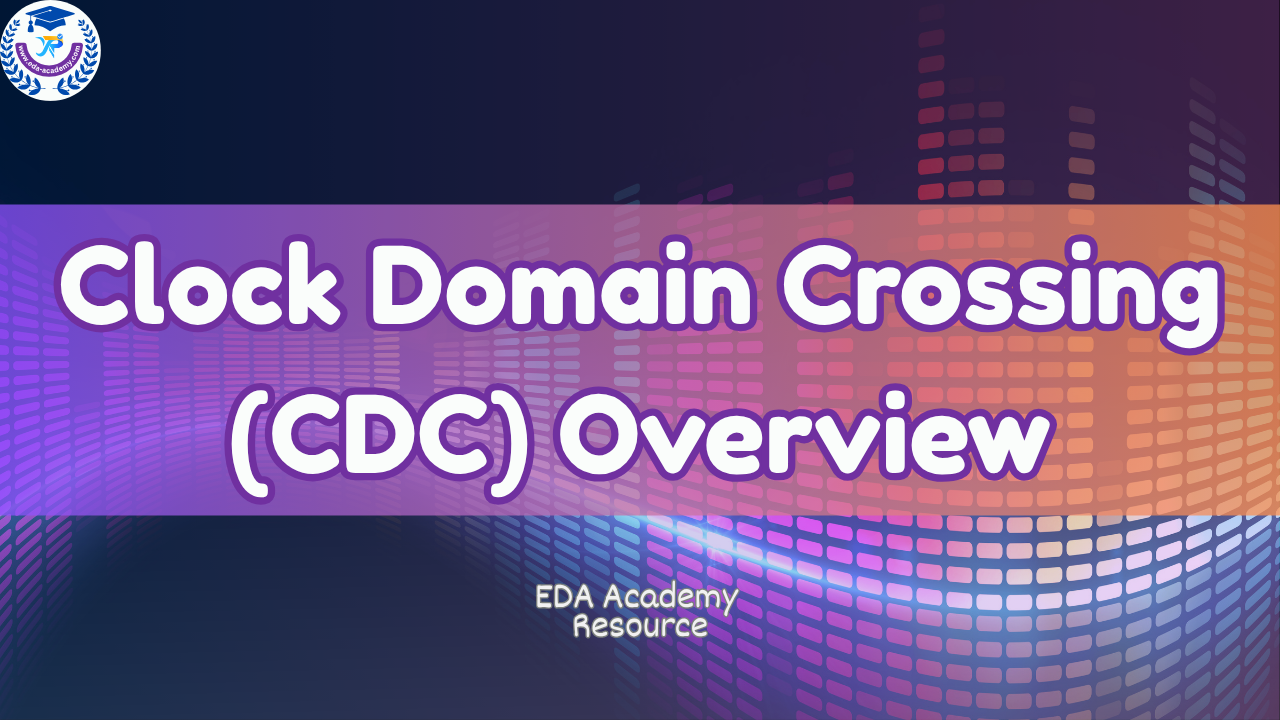Resource:
Clock Domain Crossing (CDC) Overview (English)
Clock domain crossing (CDC) introduces complex challenges in digital design, where asynchronous clock boundaries can result in metastability, timing violations, and data integrity risks. Key issues include glitch propagation, multi-fanout inconsistencies, and improper synchronization. Understanding metastability fundamentals, modeling techniques, and structural and functional hazards is critical. This includes signal divergence, instability from data transitions, and encoding errors like improper use of Gray code. Effective CDC handling requires robust synchronization schemes—such as NDFF, MUX, handshake, FIFO, pulse, and edge synchronizers—combined with quantitative reliability analysis like Mean Time Between Failure (MTBF) to ensure functional correctness across asynchronous domains.
Purchase
Our course syllabus is regularly updated to reflect the latest advancements and best practices in the field. For individually purchased courses or resources with lifetime access, students can always access the content and receive updates for free. For members, all member-free courses and resources — including future updates — are accessible during the active subscription period. This ensures that both lifetime purchasers and active members can benefit from the most relevant and up-to-date content.
Created by EDA Academy
English
Last updated June 2025

Resource: Clock Domain Crossing (CDC) Overview (English)
OR
USD $99.9
-70%Today
$29.9
One-time Purchase
& Lifetime Access
What you will get:
1.2 Hours of Immersive, High-Quality Video Lessons
Professionally produced and delivered by our expert team, covering core concepts and practical demonstrations, with step-by-step explanations and real-life examples to help you efficiently absorb knowledge and apply it immediately in a short time.
Certificate of completion
Upon successful completion of the course, you will receive an official certificate issued by EDA Academy, adding value to your resume and career development.
Access on mobile and computer
The course can be viewed anytime on mobile phones, tablets, and computers, allowing you to learn easily whether at the office, at home, or on the go.
Ongoing support from EDA Academy
After the course ends, you will continue to receive ongoing support from our team to help you consolidate knowledge and solve practical problems.
Further learning plan
Provides you with follow-up learning paths and recommended resources, enabling you to continue improving your skills and expanding your career development based on what you have learned.
Resource Catalogue
Description
Clock domain crossing arises when signals are transferred between functional blocks operating under independent clock sources. The lack of temporal correlation between these domains introduces significant risk of metastability, where a flip-flop may enter an indeterminate voltage state if its setup or hold requirements are violated. This metastable state can propagate incorrect values downstream and cause unpredictable functional behavior. Understanding the timing violation mechanisms and the probability of occurrence under varying clock frequencies and signal transitions is essential for mitigating these risks at the architectural level.
Fundamentals of metastability must be carefully modeled and quantified. Circuit behavior during metastable resolution is characterized by time-dependent exponential decay, requiring statistical analysis to determine Mean Time Between Failure (MTBF). Modeling techniques consider metastability window width, clock frequency, flip-flop characteristics, and propagation depth. MTBF estimation provides a measurable target for evaluating synchronizer effectiveness under worst-case operating conditions. Signal divergence, where metastable signals fan out to multiple logic destinations and cause inconsistent states, must be thoroughly analyzed and structurally prevented.
Structural integrity of asynchronous crossings is another core consideration. Glitches, caused by combinational logic reacting to asynchronous changes, can create transient pulses that violate timing assumptions. Multi-fanout structures, where a single asynchronous source drives several endpoints, may lead to sampled inconsistencies if not all destinations resolve the metastable condition identically. These issues are difficult to detect through simulation alone and often require formal verification or structural checking tools that trace potential hazard propagation paths across the design netlist.
Functionally, asynchronous crossings face risks related to data stability and encoding schemes. Multi-bit data lines must maintain consistent values during capture windows; otherwise, partial updates may be latched, leading to corrupted control or data words. Gray code is often used to address this, especially in pointer-based communication such as FIFO status signaling. However, improper implementation can introduce subtle bugs. Additional functional concerns include race conditions, signal contention, and unstable control signaling. Ensuring temporal isolation and logical convergence across domains is necessary to maintain safe and predictable system behavior.
Reliable CDC handling requires the deployment of robust synchronization schemes tailored to the type and timing of signals involved. NDFF synchronizers are the most common solution for single-bit control signals. MUX synchronizers allow conditional data selection, while handshake synchronizers provide explicit acknowledgement mechanisms. FIFO-based schemes support bulk data transfer with asynchronous read/write clocks. Pulse synchronizers capture narrow transitions, and edge synchronizers detect specific clock transitions between domains. Each architecture balances trade-offs in latency, power, and area. Accurate implementation must consider timing arcs, signal polarity, and clock relationships.
By comprehensively addressing metastability theory, structural signal hazards, functional correctness, and synchronization architecture, CDC design becomes a predictable and controllable component of digital system integration. The ability to identify, classify, and resolve CDC issues early in the physical design phase significantly improves system reliability and reduces the risk of elusive bugs that escape simulation and manifest in silicon.
We HATE spam. Your email address is 100% secure
The document will be emailed to you. Please check your Spam folder if it doesn’t appear in your inbox.
We HATE spam. Your email address is 100% secure
